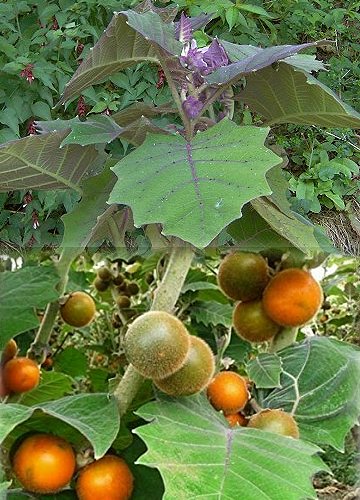
|
|
Naranjilla - Lulo
(Solanum quitoense).
|
Naranjilla - Lulo - Solanum quitoense
An intriguing and highly appealing member of the nightshade family, Solanaceae, the
naranjilla, Solanum quitoense Lam. (syn. S. angulatum Lam.), is a tropical perennial plant from northwestern South
America. Acquired its Spanish name, meaning "little orange" because it is
round, and is bright-orange when fully ripe. In Ecuador it is called naranjilla de
Quito, or nuqui; in Peru, naranjita de Quito. The Incas called it lulum. In
Mexico, it is lulun; in Colombia, lulo, naranjilla or toronja. Variety septentrionale Schultes &
Cuatr. is called lulo de castilla, lulo de perro, or lulo morado. The specific name for this species of nightshade means
"from Quito".
Naranjilla are delicate plants and must be protected from strong winds and direct
sunlight. They grow best in partial shade. This is one of the most esteemed fruit crops in Andean South
America, where the raw fruits are sweetened to make a delicious juice. The plant is often cultivated for its fruit in northwestern S. America
and, in recent years, its cultivation has spread to many other tropical and subtropical
areas.
The naranjilla plant is a spreading, herbaceous shrub to 8 ft (2.5 m) high with thick stems that become somewhat woody with
age; spiny in the wild, spineless in cultivated plants. The alternate leaves are
oblong-ovate, to 2 ft (60 cm) long and 18 in (45 cm) wide, soft and woolly. There may be few or many spines on
petioles, midrib and lateral veins, above and below, or the leaves may be completely
spineless. Young leaves, young stems and petioles are coated with richly purple stellate
hairs. Hairs on other parts may appear simple. Borne in short axillary clusters of as many as 10, the fragrant
flowers, about 1 1/5 in (3 cm) wide, have 5 petals, white on the upper surface, purple hairy
beneath, and 5 prominent yellow stamens. The unopened buds are likewise covered with purple
hairs.
The fruit is up to 5cm in diameter and is produced in clusters of 3 - 4
fruits. A brown, hairy coat protects the fruit until it is fully ripe, when the hairs can be easily rubbed
off, showing the bright-orange, smooth, leathery, fairly thick peel. The fruit, crowned with the
persistent, 5-pointed calyx, is round or round-ovate, to 2 1/2 in (6.25 cm) across and contains 4 compartments separated by membranous partitions and filled with translucent green or
yellowish, very juicy, slightly acid to acid, pulp of delicious flavor which has been likened to
pineapple-and-lemon. There are numerous pale-buff seeds, thin, flat, hard and 1/8 in (3
mm) in diameter.
Ripe naranjillas, freed of hairs, may be casually consumed
out-of-hand by cutting in half and squeezing the contents of each half into the
mouth. The empty shells are discarded. The flesh, complete with seeds, may be squeezed out and added to ice cream
mix, made into sauce for native dishes, or utilized in making pie and various other cooked
desserts. The shells may be stuffed with a mixture of banana and other ingredients and
baked. But the most popular use of the naranjilla is in the form of juice. For home
preparation, the fruits are washed, the hairs are rubbed off, the fruits cut in
half, the pulp squeezed into an electric blender and processed briefly; then the green juice is
strained, sweetened, and served with ice cubes as a cool, foamy drink called
lulada. A dozen fruits will yield 8 oz (227 g) of juice. Commercially, the juice is extracted mechanically from the cleaned and chopped
fruits, strained, concentrated and canned or put into plastic bags and frozen.
Sherbet is made in the home by mixing naranjilla juice with corn
sirup, sugar, water, and a little lime juice, partially freezing, then beating to a froth and
freezing. Naranjilla jelly and marmalade are produced on a small scale in Cali,
Colombia.
The naranjilla has been proposed as a new flavoring for the global food
industry, but it fares poorly in large-scale cultivation, presenting an obstacle to its wider
use. Its fruit, like tomatoes, is easily damaged when ripe, so is usually harvested
unripe. The fruits are found at markets. It is common for locals to make beverages by adding sugar and water to the freshly squeezed
fruits.
Source:
https://en.wikipedia.org/wiki/Solanum_quitoense
http://tropical.theferns.info/viewtropical.php?id=Solanum+quitoense
https://hort.purdue.edu/newcrop/morton/naranjilla_ars.html
